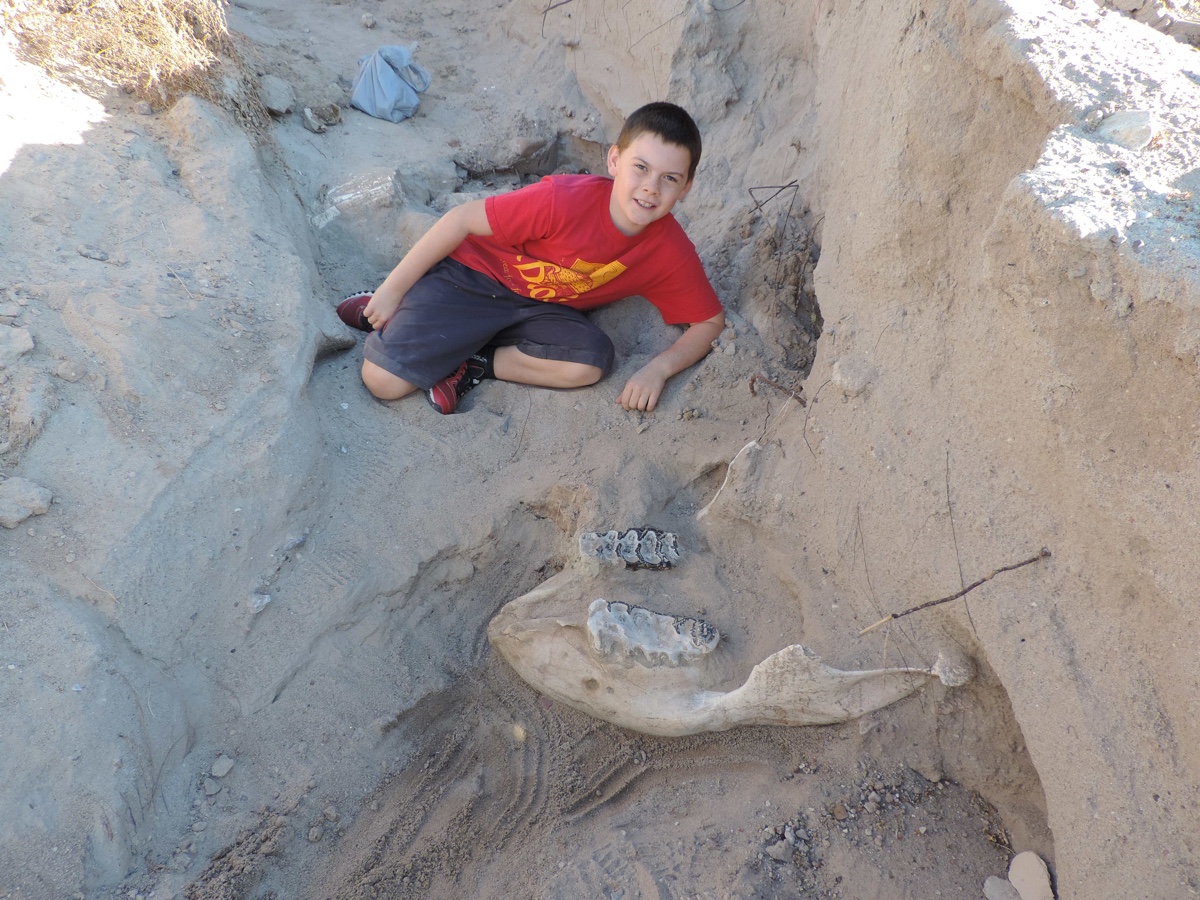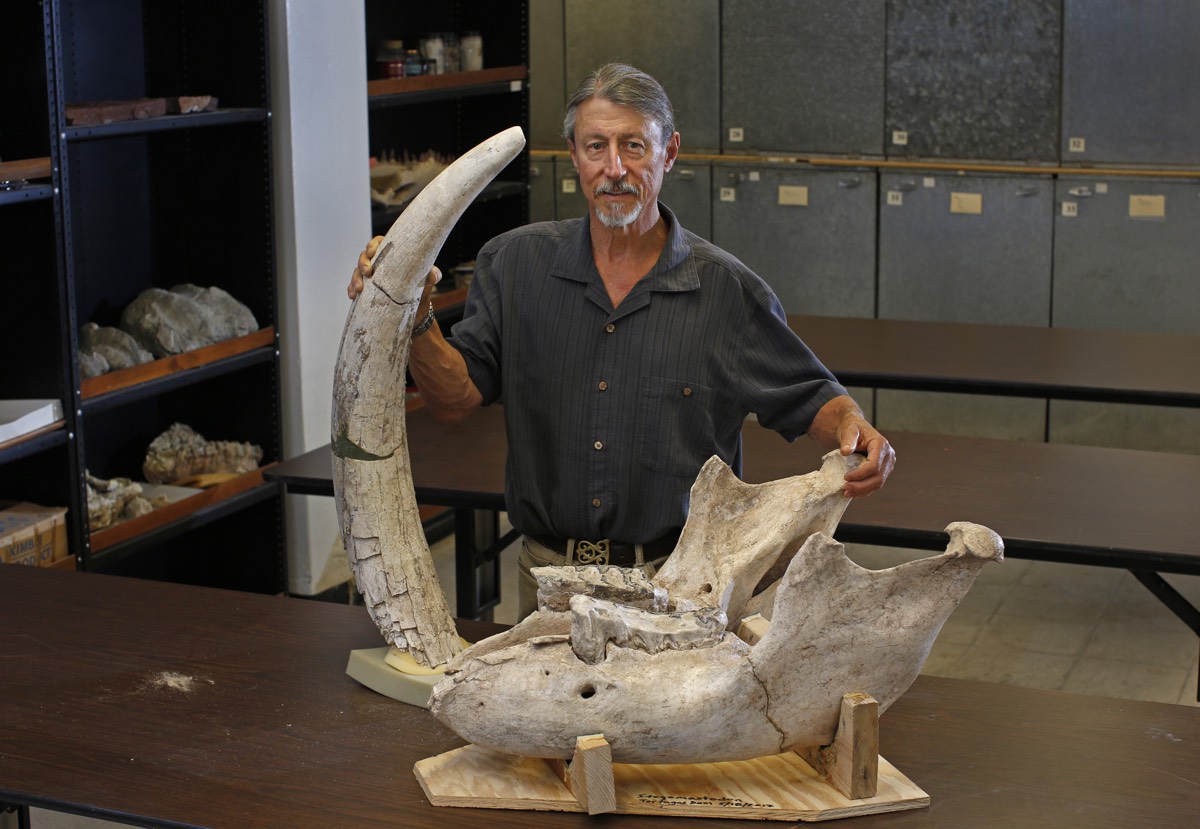Boy Face-Plants Right Onto a Million-Year-Old Stegomastodon Skull

A 9-year-old boy hiking in the Las Cruces desert in New Mexico recently tripped over what is now thought to be a 1.2-million-year-old Stegomastodon skull.
"I was running farther up, and I tripped on part of the tusk," Jude Sparks, now 10, who was hiking in the desert with his parents and brothers, said in a statement from New Mexico State University (NMSU). "My face landed next to the bottom jaw. I looked farther up, and there was another tusk."
A prehistoric ancestor of mammoths and elephants, Stegomastodon belongs to the scientific family Gomphotheriidae. While many gomphotheres sported four tusks — an upper pair that curved downward and outward, and a lower pair that were sort of spatula-shaped — Stegomastodon had just two upward-curving tusks, sometimes called chin tusks, that grew downward from the upper jaw. [See Photos of Another Stegomastodon Skull Unearthed in New Mexico]
After realizing Jude had tripped on a fossilized tusk, the Sparks contacted Peter Houde, a biology professor at NMSU who is also the curator-in-charge at the university's The Vertebrate Museum.
"A stegomastodon would look to any of us like an elephant," Houde said in a statement. "For the several types of elephants that we have in the area, this is probably one of the more common of them. But they're still very rare. This may be only the second complete skull found in New Mexico." (In fact, in 2014, a bachelor party stumbled across a 3-million-year-old Stegomastodon skull in Elephant Butte Lake State Park in New Mexico.)

Although Stegomastodon also would've looked pretty similar to a mastodon, the two are in different family groups, according to Ross MacPhee, curator professor of Mammalogy/Vertebrate Zoology at the American Museum of Natural History in New York City. "The American mastodon, Mammut americanum, is a mammutid and in a different family group," Macphee told Live Science, adding that Stegomastodon fossils are not common.
Physically they would have looked quite a bit alike as primitive proboscideans. Scientists excavated the fossilized jaw and two pieces of the tusk last fall. Then, in May, the Sparks and a team of students and professors unearthed the skull.
Sign up for the Live Science daily newsletter now
Get the world’s most fascinating discoveries delivered straight to your inbox.
It took months for Houde to get permission to dig on the site and to acquire the chemicals needed to preserve the skull once unearthed, Houde said.
The jaw weighs about 120 lbs. (54 kilograms), while the entire skull is about a ton (0.9 metric tons), which is actually light for such a huge bone, Houde said. That suggested the animal was about the same size "as an asian elephant, but with somewhat stockier legs," Houde told Live Science.
"The upper part of the skull is deceiving. It's mostly hollow, and the surface of the skull is eggshell thin," Houde said. "You can imagine an extremely large skull would be very heavy for the animal if it didn't have air inside it to lighten it up, just like our own sinuses."
The fragile skull was held together essentially by the surrounding sediment, he added. When sediment is removed from these specimens, they "fall apart immediately and literally fall into tiny, tiny bits," Houde said in the statement.
As such, Houde and his team spent a week painstakingly carving the skull from its surroundings. For instance, after carefully brushing away bits of dirt from the skull, the team applied chemical hardeners to keep the ancient bones from cracking.
"As we were brushing away the fossil, as soon as we removed the sediment, we needed to put a type of hardener on there to preserve the structural integrity," Danielle Peltier, a geology student at NMSU who helped with the dig, said in the statement. "Otherwise, it would just crumble after a few days being left in the sun." [Photos: Ice-Age Animal Bones Unearthed During LA Subway Construction]
Once they got the skull out of the ground, the team coated it with plaster and attached wooden braces to it for support. A front-end loader then lifted the skull into a truck to be taken back to the university.
The skull and the tusks will be studied and reconstructed, which could take years. Then, it likely will go on display at a museum.
"I have every hope and expectation that this specimen will ultimately end up on exhibit and this little boy will be able to show his friends, and even his own children, 'Look what I found right here in Las Cruces,'" Houde said.
As for the rest of the animal's remains, there's a chance they are hiding nearby. "It's quite possible it was preserved," Houde told Live Science. "The fact that we found both the skull and jaw together suggests that the bones were held together as they were deposited."
Even so, he added the two complete, or near-complete, Stegomastodon skeletons found to date were scattered over an area extending 30 feet (9 meters), he said. "It would require a lot of earth-moving for us to explore that far into the hillside where ours was found. It will be up to the land owner how far we can explore. It is entirely possible that the rest of the skeleton was preserved there, but eroded away thousands of years ago."
Original article on Live Science.
Jeanna Bryner is managing editor of Scientific American. Previously she was editor in chief of Live Science and, prior to that, an editor at Scholastic's Science World magazine. Bryner has an English degree from Salisbury University, a master's degree in biogeochemistry and environmental sciences from the University of Maryland and a graduate science journalism degree from New York University. She has worked as a biologist in Florida, where she monitored wetlands and did field surveys for endangered species, including the gorgeous Florida Scrub Jay. She also received an ocean sciences journalism fellowship from the Woods Hole Oceanographic Institution. She is a firm believer that science is for everyone and that just about everything can be viewed through the lens of science.









